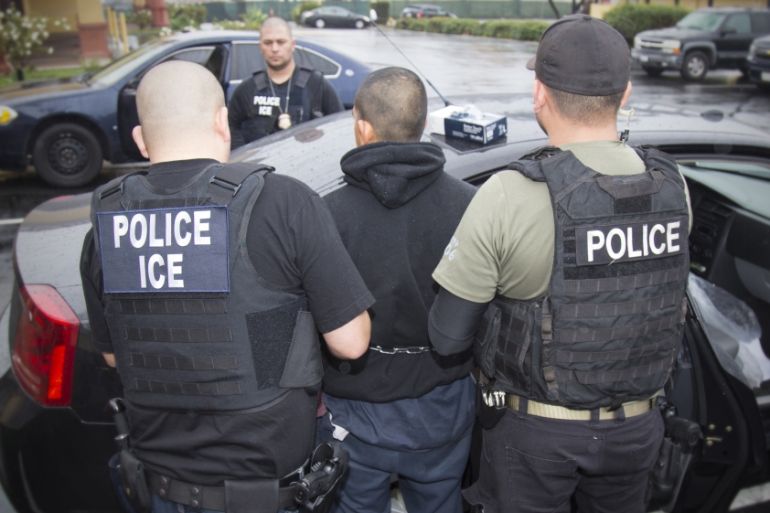US immigration arrests up 30 percent in 2017
US immigration arrests hit a three-year high in 2017, with the largest surges recorded in Florida, Texas and Oklahoma.

The number of undocumented immigrants arrested in the United States rose to a three-year high in 2017, reversing several years of decline, according to new figures.
Pew Research Center, a think-tank, said on Thursday that a total of 143,470 people were held by US Immigration and Customs Enforcement (ICE) officials last year – up 30 percent compared with 2016.
Keep reading
list of 4 itemsCyprus suspends asylum applications for Syrians as arrivals rise
Agadez, Niger’s gateway to the Sahara, finds new life in the migrant trade
Forced from home, these Colombians struggle to live in a basketball stadium
ICE enforces federal immigration laws inside the US and has the power to detain and deport undocumented immigrants.
“The surge began after President Donald Trump took office in late January [2017],” the Centre, which analysed ICE statistics on administrative arrests, said in a statement.
Administrative arrest is the term used to describe the arrest of an undocumented immigrant in civil violation of US immigration laws.
The largest increase in arrests was recorded in Florida, northern Texas and Oklahoma, Pew said. More than 16,500 arrests were recorded in the Dallas area of Texas alone.
Arrests also jumped by more than 50 percent between 2016 and 2017 in the areas around the cities of New Orleans, Atlanta, Boston and Detroit.
However, ICE arrests across the US were twice as high in 2009, the year Trump’s predecessor, former US President Barack Obama, came into office.
ICE officers carried out nearly 298,000 arrests in 2009, but “this total generally declined in subsequent years,” Pew reported.
‘Interior enforcement’
In January 2017, Trump signed an executive order bolstering “interior enforcement” of US immigration laws, and giving local and state law enforcement agencies the power to act in the capacity of immigration enforcement officers.
By contrast, arrests made by US Customs and Border Protection (CBP), which enforces US immigration laws at the country’s borders, declined by 25 percent between 2016 and 2017, Pew reported.
ICE justifies the “interior” arrests as part of the agency’s “continued commitment to identifying, arresting, and removing aliens who are in violation of US law, particularly those posing a public safety or national security threat”.
However, the 2017 figures come amid several arrests that some say demonstrate the arbitrary nature and destructive effect of US immigration detention and deportation policies.
In late January, for example, ICE officers arrested a Kansas professor who has lived in the US for three decades, US media reported.
Originally from Bangladesh, Syed Ahmed Jamal, was arrested by ICE agents on his front lawn as he was about to take his daughter to school. Jamal, a father of three children, all of whom hold US citizenship, now faces deportation.
Also last month, ICE arrested and deported Amer Othman Adi, a Palestinian man who has lived in Ohio for nearly 40 years.
Adi was “ripped from his four daughters, his wife, and the country that he has called home for over 30 years”, Representative Tim Ryan of Ohio, who fought his deportation, said in a statement at the time.
Meanwhile, Trump has also sought to withhold federal funding from so-called sanctuary cities, though that effort was blocked by a California court in April last year.
In general, a sanctuary city will allow all residents to access municipal services, regardless of their immigration status.
City officials will also not cooperate with federal immigration enforcement officers when it comes to detaining and deporting undocumented residents.
Hundreds of US cities and states have declared sanctuary policies in recent years.